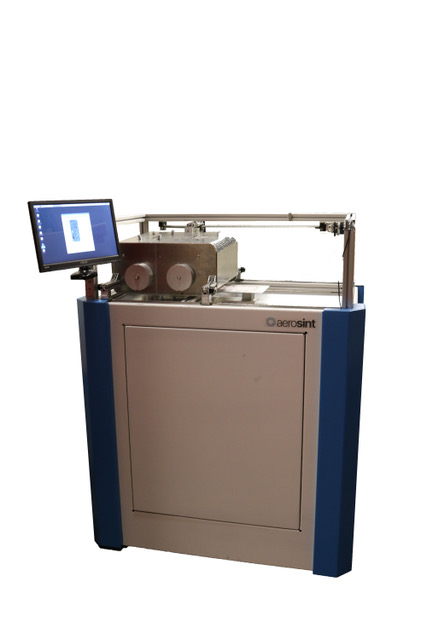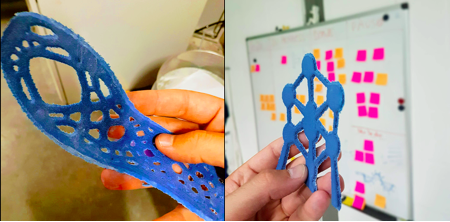Aerosint is a spin-out of the Belgian factory “MAKE IT GROUP”. Created in 2015, the company has officially been incorporated as Aerosint in September 2016. It is an engineering company that specializes in multi-material 3D printing.
After a successful first fund raising in 2017 with the help of The Innovation Fund, Aerosint recently secured a financing round of 850K €. Edouard Moens, co-founder and CEO of the company, unveils the project and the vision of the team. #OpinionoftheWeek
Tell us more about Aerosint
Aerosint is a spin-out of MAKE IT GROUP, an innovation studio. Following our first financing round in February 2017 with The Innovation Fund, we recently closed a second fundraising with the help of a private investor, Peter Mercelis.
We now have three patents pending. A first prototype of our technology is already available. It is a print head that can be integrated into a SLM industrial machine. The print head allows for the first tests of powders used in SLS technology as well as polymers.
The first fund raising enabled us to further develop the technology, new versions of the head for metal 3D printing and ceramic 3D printing as well as strengthen our intellectual property portfolio.
Is there already a defined offering?
We’re still in the development stage. However, we will firstly commercialize our printhead to manufacturers of SLM machines who would be interested in integrating it into their machines before commercializing them. We might also offer the transformation of SLM systems.
For now, SLM machines are the only type of systems on which we can integrate our print head because our prototype was manufactured based on such type of machines. The print head basically enables SLM machines to print several materials at the same time.
How does your multi-material printing technology distinguish itself from others of the same range?
First of all, traditional SLM technology has been around for about 30 years. A major shortcoming of SLS/SLM is that they are inherently single material. In other terms, due to the fact that powders are created using a specific blade, this technology only allows the creation of objects with the same material. Indeed, the blade can only be used to make layers that are single materials.
Our technology is different to the extent that it enables the deposition of a powder system that can integrate different materials. These materials are therefore precisely deposited where needed in order to create multi-material layers.
Our process replaces this blade with a powder system to create multi-material powders.
 What materials can be used with your system?
What materials can be used with your system?
Our technology works with all materials used in 3D printing: polymers and metals.
What type of applications could you achieve?
First of all, as far as single-material printing is concerned, it is possible to use a non-degradable support powder that can be 100% recycled.
Furthermore, in traditional SLM technology, there is a lot of waste, which does not exist with our process. Our technology therefore enables to save materials.
On the other side, one can explore a range of possibilities with multi-material 3D printing, be it with polymers or metals. For instance, it is possible to combine materials with different properties and colours… There is a variety of possibilities but we are still in a discovery phase in terms of applications.
 What can we expect from this financing round?
What can we expect from this financing round?
Research and development will be pushed forward. We will hire more people to strengthen the team and above all, we benefit from the expertise of Peter Mercelis. He does not only have a huge network that might be useful to us, he can also bring us a lot of credibility.
Let’s talk about Belgium. In your opinion, what actions should be implemented to further develop the 3D printing industry?
Belgium already holds an ecosystem that is already well implemented. Companies such as Materialise, Melotte or Sirris (specialist in research and development) have been there for a while. This demonstrates that there is already some expertise that is quite acknowledged.
At the industrial level, things are not always very clear. Industrials do not always know how to integrate the technology, neither its potential, nor the benefits they might have. A focus should be made on communication at this level.
As for multi-material 3D printing, this aspect brings another level of complexity because very few companies specialize in this sector. Anyway, it’s very scarce.
Any last words?
Our mission is to further optimize the parts that companies produce. We are convinced that multi-material 3D printing is the next revolution in the industry. It can enable the production of multi-material parts with optimized material composition for optimized functionality, all at a reasonable cost and with minimal material waste. Lastly, we believe we are well positioned on this market and we have not yet seen a technology that can offer another alternative to what we are doing.
For those who discover Aerosint, what can you tell them?
We are always looking forward to discovering new applications… If you believe a new application is achievable in multi-material 3D printing, do not hesitate to contact us. We are always curious to discover more.
For further information about 3D Printing, follow us on our social networks and subscribe to our newsletter! Would you like to subscribe to 3D Adept Mag? Would you like to be featured in the next issue of our digital magazine? Send us an email at contact@3dadept.com





